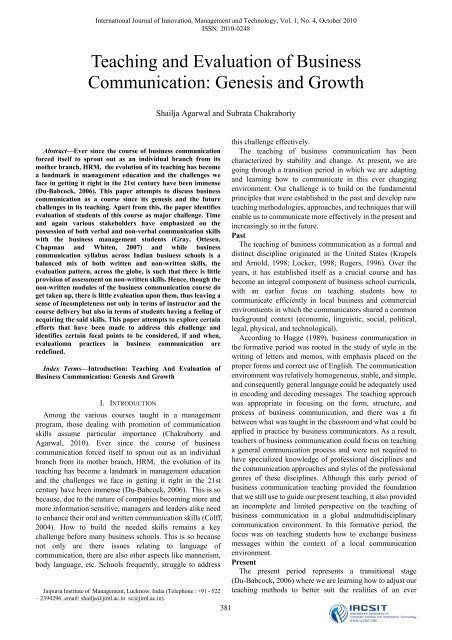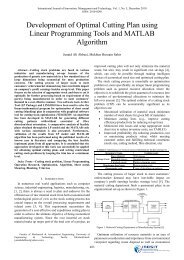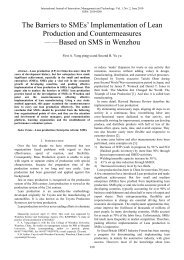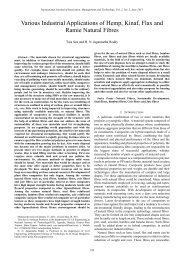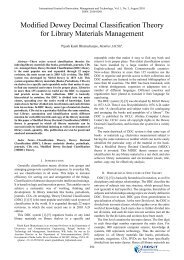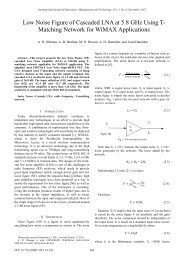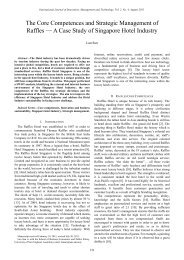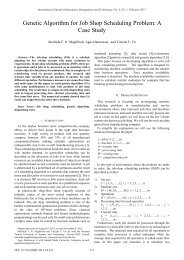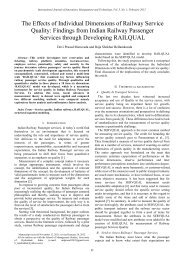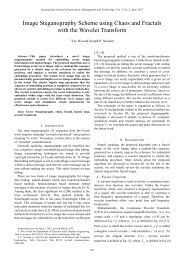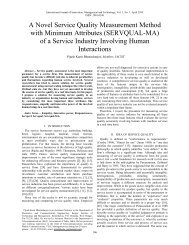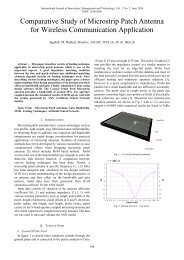Teaching and Evaluation of Business Communication ... - ijimt
Teaching and Evaluation of Business Communication ... - ijimt
Teaching and Evaluation of Business Communication ... - ijimt
Create successful ePaper yourself
Turn your PDF publications into a flip-book with our unique Google optimized e-Paper software.
International Journal <strong>of</strong> Innovation, Management <strong>and</strong> Technology, Vol. 1, No. 4, October 2010<br />
ISSN: 2010-0248<br />
<strong>Teaching</strong> <strong>and</strong> <strong>Evaluation</strong> <strong>of</strong> <strong>Business</strong><br />
<strong>Communication</strong>: Genesis <strong>and</strong> Growth<br />
Shailja Agarwal <strong>and</strong> Subrata Chakraborty<br />
Abstract—Ever since the course <strong>of</strong> business communication<br />
forced itself to sprout out as an individual branch from its<br />
mother branch, HRM, the evolution <strong>of</strong> its teaching has become<br />
a l<strong>and</strong>mark in management education <strong>and</strong> the challenges we<br />
face in getting it right in the 21st century have been immense<br />
(Du-Babcock, 2006). This paper attempts to discuss business<br />
communication as a course since its genesis <strong>and</strong> the future<br />
challenges in its teaching. Apart from this, the paper identifies<br />
evaluation <strong>of</strong> students <strong>of</strong> this course as major challenge. Time<br />
<strong>and</strong> again various stakeholders have emphasized on the<br />
possession <strong>of</strong> both verbal <strong>and</strong> non-verbal communication skills<br />
with the business management students (Gray, Ottesen,<br />
Chapman <strong>and</strong> Whiten, 2007) <strong>and</strong> while business<br />
communication syllabus across Indian business schools is a<br />
balanced mix <strong>of</strong> both written <strong>and</strong> non-written skills, the<br />
evaluation pattern, across the globe, is such that there is little<br />
provision <strong>of</strong> assessment on non-written skills. Hence, though the<br />
non-written modules <strong>of</strong> the business communication course do<br />
get taken up, there is little evaluation upon them, thus leaving a<br />
sense <strong>of</strong> incompleteness not only in terms <strong>of</strong> instructor <strong>and</strong> the<br />
course delivery but also in terms <strong>of</strong> students having a feeling <strong>of</strong><br />
acquiring the said skills. This paper attempts to explore certain<br />
efforts that have been made to address this challenge <strong>and</strong><br />
identifies certain focal points to be considered, if <strong>and</strong> when,<br />
evaluatiomn practices in business communication are<br />
redefined.<br />
Index Terms—Introduction: <strong>Teaching</strong> And <strong>Evaluation</strong> <strong>of</strong><br />
<strong>Business</strong> <strong>Communication</strong>: Genesis And Growth<br />
I. INTRODUCTION<br />
Among the various courses taught in a management<br />
program, those dealing with promotion <strong>of</strong> communication<br />
skills assume particular importance (Chakraborty <strong>and</strong><br />
Agarwal, 2010). Ever since the course <strong>of</strong> business<br />
communication forced itself to sprout out as an individual<br />
branch from its mother branch, HRM, the evolution <strong>of</strong> its<br />
teaching has become a l<strong>and</strong>mark in management education<br />
<strong>and</strong> the challenges we face in getting it right in the 21st<br />
century have been immense (Du-Babcock, 2006). This is so<br />
because, due to the nature <strong>of</strong> companies becoming more <strong>and</strong><br />
more information sensitive, managers <strong>and</strong> leaders alike need<br />
to enhance their oral <strong>and</strong> written communication skills (Colff,<br />
2004). How to build the needed skills remains a key<br />
challenge before many business schools. This is so because<br />
not only are there issues relating to language <strong>of</strong><br />
communication, there are also other aspects like mannerism,<br />
body language, etc. Schools frequently, struggle to address<br />
Jaipuria Institute <strong>of</strong> Management, Lucknow, India (Telephone : +91 - 522<br />
– 2394296, email: shailja@jiml.ac.in sc@jiml.ac.in).<br />
381<br />
this challenge effectively.<br />
The teaching <strong>of</strong> business communication has been<br />
characterized by stability <strong>and</strong> change. At present, we are<br />
going through a transition period in which we are adapting<br />
<strong>and</strong> learning how to communicate in this ever changing<br />
environment. Our challenge is to build on the fundamental<br />
principles that were established in the past <strong>and</strong> develop new<br />
teaching methodologies, approaches, <strong>and</strong> techniques that will<br />
enable us to communicate more effectively in the present <strong>and</strong><br />
increasingly so in the future.<br />
Past<br />
The teaching <strong>of</strong> business communication as a formal <strong>and</strong><br />
distinct discipline originated in the United States (Krapels<br />
<strong>and</strong> Arnold, 1998; Locker, 1998; Rogers, 1996). Over the<br />
years, it has established itself as a crucial course <strong>and</strong> has<br />
become an integral component <strong>of</strong> business school curricula,<br />
with an earlier focus on teaching students how to<br />
communicate efficiently in local business <strong>and</strong> commercial<br />
environments in which the communicators shared a common<br />
background context (economic, linguistic, social, political,<br />
legal, physical, <strong>and</strong> technological).<br />
According to Hagge (1989), business communication in<br />
the formative period was rooted in the study <strong>of</strong> style in the<br />
writing <strong>of</strong> letters <strong>and</strong> memos, with emphasis placed on the<br />
proper forms <strong>and</strong> correct use <strong>of</strong> English. The communication<br />
environment was relatively homogeneous, stable, <strong>and</strong> simple,<br />
<strong>and</strong> consequently general language could be adequately used<br />
in encoding <strong>and</strong> decoding messages. The teaching approach<br />
was appropriate in focusing on the form, structure, <strong>and</strong><br />
process <strong>of</strong> business communication, <strong>and</strong> there was a fit<br />
between what was taught in the classroom <strong>and</strong> what could be<br />
applied in practice by business communicators. As a result,<br />
teachers <strong>of</strong> business communication could focus on teaching<br />
a general communication process <strong>and</strong> were not required to<br />
have specialized knowledge <strong>of</strong> pr<strong>of</strong>essional disciplines <strong>and</strong><br />
the communication approaches <strong>and</strong> styles <strong>of</strong> the pr<strong>of</strong>essional<br />
genres <strong>of</strong> these disciplines. Although this early period <strong>of</strong><br />
business communication teaching provided the foundation<br />
that we still use to guide our present teaching, it also provided<br />
an incomplete <strong>and</strong> limited perspective on the teaching <strong>of</strong><br />
business communication in a global <strong>and</strong>multidisciplinary<br />
communication environment. In this formative period, the<br />
focus was on teaching students how to exchange business<br />
messages within the context <strong>of</strong> a local communication<br />
environment.<br />
Present<br />
The present period represents a transitional stage<br />
(Du-Babcock, 2006) where we are learning how to adjust our<br />
teaching methods to better suit the realities <strong>of</strong> an ever
International Journal <strong>of</strong> Innovation, Management <strong>and</strong> Technology, Vol. 1, No. 4, October 2010<br />
ISSN: 2010-0248<br />
evolving <strong>and</strong> more complex, globalized, <strong>and</strong><br />
multidisciplinary communication <strong>and</strong> teaching environment.<br />
With economic expansion to all parts <strong>of</strong> world,<br />
communicators are faced with the prospect <strong>of</strong> encoding <strong>and</strong><br />
decoding an ever larger volume <strong>of</strong> more diversified messages.<br />
In this environment, individuals increasingly interact directly<br />
<strong>and</strong> indirectly in interconnected global communication<br />
networks <strong>and</strong> create interrelated global value-added chains<br />
(Porter, 1985) in their roles as producers <strong>and</strong> customers. As<br />
pr<strong>of</strong>essionals increasingly use more complex <strong>and</strong> distinctive<br />
pr<strong>of</strong>essional genres (see Bhatia, 2004), communication<br />
barriers are created as these pr<strong>of</strong>essionals interact with<br />
pr<strong>of</strong>essionals from other disciplines <strong>and</strong> with non-specialists,<br />
representing different cultures <strong>and</strong> possessing various levels<br />
<strong>of</strong> genre <strong>and</strong> subject knowledge, language, <strong>and</strong> culture<br />
competency.<br />
Future<br />
Our challenge is to teach students how to cope with <strong>and</strong><br />
communicate in this increasingly complex <strong>and</strong> diverse global,<br />
multidisciplinary communication environment. The<br />
concurrent migration <strong>of</strong> workers <strong>and</strong> international relocation<br />
<strong>of</strong> production facilities have also created multilingual <strong>and</strong><br />
multicultural workforces <strong>and</strong> the need to communicate more<br />
efficiently <strong>and</strong> effectively in multiple languages <strong>and</strong> in<br />
face-to-face communication. Our challenges to the future are<br />
to learn how to communicate in an information-overloaded<br />
environment, how to encode <strong>and</strong> decode messages within<br />
interactants at varying competency levels, <strong>and</strong> how to use <strong>and</strong><br />
choose among communication media <strong>and</strong> technologies. The<br />
framework <strong>of</strong> business communication that has been<br />
developed in the past <strong>and</strong> present periods should now be used<br />
as the platform from which to extend <strong>and</strong> enrich our<br />
discipline <strong>and</strong> our teaching.<br />
A key factor in the need to adapt to <strong>and</strong> embrace the future<br />
is the advancements made in technology. Current<br />
technologies are influencing not only the way businesses<br />
communicate globally but also the way in which teaching,<br />
learning, <strong>and</strong> research can be done collaboratively.<br />
The challenge for us is how to move into the future stage<br />
when we are still learning how to adjust our teaching to better<br />
suit the realities <strong>of</strong> an increasingly complex <strong>and</strong> diverse<br />
global communication environment. As teachers <strong>of</strong> business<br />
communication, we should focus on developing <strong>and</strong> training<br />
our students to adapt <strong>and</strong> communicate effectively in current<br />
<strong>and</strong> future communication environments <strong>and</strong> develop their<br />
competencies to:<br />
1) interact in a multilingual <strong>and</strong> multicultural environment<br />
in which individuals possess various levels <strong>of</strong> language<br />
pr<strong>of</strong>iciency <strong>and</strong> use different pr<strong>of</strong>essional genres,<br />
2) adjust to the varying linguistic <strong>and</strong> cultural competencies<br />
<strong>of</strong> their communication partners, <strong>and</strong><br />
3) use communication technologies effectively to provide<br />
real-time information <strong>and</strong> message exchange with<br />
counterparts in remote locations <strong>and</strong> in virtual<br />
organizations.<br />
II. EVALUATION CHALLENGES IN BUSINESS<br />
COMMUNICATION<br />
Amidst these challenges <strong>of</strong> teaching business<br />
communication in accordance with the ever changing needs<br />
<strong>of</strong> the ever changing business environment, there is another<br />
<strong>and</strong> equally, if not bigger, significant challenge, which is <strong>of</strong><br />
coming up with a fair <strong>and</strong> objective method <strong>of</strong> evaluation <strong>of</strong><br />
students while the course is in progress, including at the stage<br />
<strong>of</strong> its completion. Problems arise because <strong>of</strong> certain stated<br />
<strong>and</strong> implied needs. These are: reliability, validity, objectivity<br />
<strong>and</strong> verifiability. A proper solution <strong>of</strong>ten remains elusive.<br />
Cowan (1999, RGU Year <strong>of</strong> Assessment Workshop) states,<br />
“assessment is the powerhouse <strong>of</strong> learning. It is the engine<br />
that drives learning”.<br />
In most educational programs, a substantial proportion <strong>of</strong><br />
teacher <strong>and</strong> student time is devoted to activities which<br />
involve (or lead directly to) evaluation by the teacher (Crooks,<br />
1988) <strong>and</strong> much evaluation <strong>of</strong> teaching focuses on what<br />
teachers do in class (Juwah, 2003). The same is true <strong>of</strong> a<br />
program in business management. Though the idea <strong>of</strong><br />
evaluation “generally evokes groans” (Feinberg, 1979) from<br />
the instructors as well as the students, it has powerful<br />
impacts- direct <strong>and</strong> indirect, positive or negative, deserving<br />
considerations towards a very careful planning <strong>and</strong><br />
implementation.<br />
In the early 1970s researchers (Snyder, 1971; Miller <strong>and</strong><br />
Parlett, 1974) were engaged in studies <strong>of</strong> student learning at<br />
prestigious universities. What they found was that,<br />
unexpectedly, what influenced students most was not the<br />
teaching but the assessment. Students described all aspects <strong>of</strong><br />
their study — what they attended to, how much work they did<br />
<strong>and</strong> how they went about their studying — as being<br />
completely dominated by the way they perceived the<br />
dem<strong>and</strong>s <strong>of</strong> the assessment system. Derek Rowntree stated<br />
that ‘if we wish to discover the truth about an educational<br />
system, we must first look to its assessment procedures’<br />
(Rowntree, 1987). More recently, qualitative studies have<br />
emphasized the importance <strong>of</strong> underst<strong>and</strong>ing the way<br />
students respond to innovations in assessment (Sambell <strong>and</strong><br />
McDowell, 1998).<br />
Boud (2002) opined that assessment must perform double<br />
duty; not only must it assess content it must also prepare<br />
learners for future learning.<br />
Juwah (2003) compiled some functions necessary to be<br />
performed for an evaluation to be effective:<br />
act as a motivator for learning (Boud, Cohen <strong>and</strong> Sampson,<br />
1999; Cowan, 1998);<br />
promote deep learning – in which the learner engages with<br />
(a) the learning materials <strong>and</strong> resources, (b) other learners<br />
<strong>and</strong> (c) tutor/facilitator (Marton <strong>and</strong> Saljo, 1984);<br />
contribute to the development <strong>of</strong> skills (Boud et al, 1999;<br />
2002; Gibbs;1992; Ramsden, 1992);<br />
be cost effective <strong>and</strong> sustainable (Boud, 2002).<br />
Past<br />
In higher education, most <strong>of</strong> the assessment is based on<br />
traditional assessment practices <strong>of</strong> essay <strong>and</strong> problem type<br />
examination. These traditional assessment practices, it has<br />
been found cannot adequately test for critical thinking,<br />
creativity, reflection etc. (Lewis <strong>and</strong> Johnson, 2002).<br />
382
International Journal <strong>of</strong> Innovation, Management <strong>and</strong> Technology, Vol. 1, No. 4, October 2010<br />
ISSN: 2010-0248<br />
In a business education program, development <strong>of</strong> a<br />
student’s ability to apply skills <strong>and</strong> knowledge in a variety <strong>of</strong><br />
contexts is a critical need (Broadfoot <strong>and</strong> Black, 2004).<br />
Therefore, assessment <strong>of</strong> student progress in acquiring this<br />
ability becomes imperative. However business education in<br />
India, <strong>and</strong> also in many parts <strong>of</strong> the world, seems to depend<br />
primarily, if not exclusively, upon the traditional examination<br />
system <strong>of</strong> essay <strong>and</strong> problem type examination, quizzes,<br />
multiple choice questions, case studies etc(Juwah, 2003) for<br />
achieving this. One apparent reason for doing so is that the<br />
method is transparent <strong>and</strong> verifiable (Juwah, 2003). Another<br />
reason could be that many business schools, inadvertently or<br />
otherwise, tend to focus more upon content knowledge <strong>and</strong><br />
hence end up using examinations to test such content<br />
knowledge in students (Ogunleye, 2006). However, to be fair<br />
to these schools, it must be said that the tools available to<br />
make assessments are also limited. The need, therefore, is to<br />
design a systematic evaluation design mechanism which, on<br />
one h<strong>and</strong>, should be transparent <strong>and</strong> objective <strong>and</strong>, on the<br />
other h<strong>and</strong>, should achieve the intended purpose. Since the<br />
results <strong>of</strong> any particular assessment device must be accorded<br />
“trust” by the stake holders if the consequences are to be<br />
acceptable, different parts <strong>of</strong> the world continue to be<br />
grappling with assessment challenges (Broadfoot <strong>and</strong> Black,<br />
2004). New tools <strong>of</strong> evaluation like use <strong>of</strong> reflection in<br />
evaluation (Thorpe, 2000), in-basket writing exercise<br />
(Feinberg, 1979), business games (McKenney, 1962) etc. are<br />
constantly being experimented upon <strong>and</strong> developed. Such<br />
experimentation helps in enriching our underst<strong>and</strong>ing <strong>of</strong> the<br />
com plexity <strong>of</strong> the many links that may exist between<br />
assessment <strong>and</strong> learning <strong>and</strong> their various interplays. As is<br />
the case in many other courses, evaluation remains a sensitive<br />
as well as a contentious aspect <strong>of</strong> the business<br />
communication course too. Needless to say, it elicits the same<br />
groans from students <strong>and</strong> instructors. Before proceeding<br />
further, it may be beneficial to remind ourselves <strong>of</strong> the<br />
primary objective <strong>of</strong> a business communication course,<br />
which is to improve communication skills <strong>of</strong> students. These<br />
skills are to be improved <strong>and</strong> assessed as a whole rather than<br />
limiting only to some components, predominantly the written<br />
skills alone.<br />
III. DISSATISFACTION WITH EVALUATION IN BUSINESS<br />
COMMUNICATION<br />
Dissatisfaction with tests currently used to assess<br />
communication ability is neither new nor uncommon. Homer<br />
L Cox, in his study, as far as 1970, observed: “Overall,<br />
educators agreed that they were most dissatisfied with, <strong>and</strong><br />
students were weakest in, ability to communicate in writing;<br />
however, dissatisfaction with tests <strong>and</strong> weakness observed<br />
varied in other areas <strong>of</strong> communication. It is probably safe to<br />
assume that other areas <strong>of</strong> communication ability are not<br />
being tested as frequently as ability to write, <strong>and</strong> weakness in<br />
these other areas may not be accurately assessed. The fact<br />
that other areas are undoubtedly less frequently measured<br />
may indicate that weakness in these areas is less easily<br />
assessed. Most effort seems to be made in improving writing<br />
ability, but writing ability remains the greatest weakness. Of<br />
course, we do not know how much worse the situation might<br />
be if efforts to improve this area were not made; but, on the<br />
other h<strong>and</strong>, we do not know how effective present efforts are.<br />
Writing may lend itself to testing; whether it should get the<br />
greatest amount <strong>of</strong> attention has not been clearly<br />
established.” It must be remembered that good<br />
communication skills comprise the four major aspects <strong>of</strong><br />
communication- LSRW. Of course, ability to distinguish<br />
between fact <strong>and</strong> assumption is also a vital part <strong>of</strong><br />
communication skills as are a number <strong>of</strong> other abilities, but a<br />
test feasible in a limited span <strong>of</strong> time can include only the<br />
items which are basic to all others, namely: LSRW. Ironically,<br />
even all these skills do not get evaluated in the traditional<br />
system <strong>of</strong> examination that is followed in communication<br />
skills evaluation in Indian business schools <strong>and</strong> across.<br />
Generally it is an assessment <strong>of</strong> writing skills through writing<br />
while research has established the importance <strong>of</strong> oral skills as<br />
well with the corporate (Mainkar <strong>and</strong> Avinash, 2008; Maes,<br />
Weldy <strong>and</strong> Icenogle, 1997; Cox, 1970). As mentioned earlier,<br />
research (Cox, 1970) establishes that assessment in areas<br />
other than written skills is less frequently measured whereby<br />
indicating that weakness in these areas is less easily assessed;<br />
hence there appears to be an acute need to develop such tools<br />
as may be helpful to assess these other areas, i.e. non-written<br />
skills.<br />
Present<br />
With such kind <strong>of</strong> challenges, business communication<br />
instructors have now, for long, been toying <strong>and</strong><br />
experimenting with the idea <strong>of</strong> peer assessment <strong>and</strong> it has<br />
gradually emerged as a focal point <strong>of</strong> experimentation <strong>and</strong><br />
research in the current scenario. In fact, most <strong>of</strong> the<br />
experiments in business communication evaluation have, in<br />
some or the other way, involved peer assessment (for<br />
example: experiments by Lynch <strong>and</strong> Golen, 1992;<br />
Gueldenzoph <strong>and</strong> May, 2002 etc).<br />
Peer assessment is an interactive <strong>and</strong> dynamic process that<br />
involves learners in assessing, critiquing <strong>and</strong> making value<br />
judgment on the quality <strong>and</strong> st<strong>and</strong>ard <strong>of</strong> work <strong>of</strong> other<br />
learners (Juwah, 2003), <strong>and</strong> providing feedback to peers to<br />
enable them enhance performance. Peer assessment is one<br />
form <strong>of</strong> innovative assessment (Mowl, 1996, McDowell <strong>and</strong><br />
Mowl, 1996), which aims to improve the quality <strong>of</strong> learning<br />
<strong>and</strong> empower learners, where traditional forms can by-pass<br />
learners' needs. It can include student involvement not only<br />
in the final judgments made <strong>of</strong> student work but also in the<br />
prior setting <strong>of</strong> criteria <strong>and</strong> the selection <strong>of</strong> evidence <strong>of</strong><br />
achievement (Biggs, 1999, Brown, Rust <strong>and</strong> Gibbs, 1994).<br />
Topping (1998) in his paper on peer assessment between<br />
students in colleges <strong>and</strong> universities provides a detailed<br />
typology <strong>of</strong> peer assessment methods. Evidence from<br />
research findings abound supporting the benefits <strong>of</strong> peer<br />
assessment to learners. These include peer learning in a<br />
non-threatening environment, the removal <strong>of</strong> power<br />
domination by the teacher over the student, the involvement<br />
<strong>of</strong> the student in the assessment process (Topping, 1998). By<br />
judging the work <strong>of</strong> others, students gain insight into their<br />
own performance. "Peer <strong>and</strong> self-assessment help students<br />
develop the ability to make judgements, a necessary skill for<br />
study <strong>and</strong> pr<strong>of</strong>essional life" (Brown, Rust <strong>and</strong> Gibbs, 1994).<br />
Brown, Rust <strong>and</strong> Gibbs (1994), Zariski (1996), Race (1998)<br />
383
International Journal <strong>of</strong> Innovation, Management <strong>and</strong> Technology, Vol. 1, No. 4, October 2010<br />
ISSN: 2010-0248<br />
<strong>and</strong> others have described some potential advantages <strong>of</strong> peer<br />
assessment for students as<br />
1) giving a sense <strong>of</strong> ownership <strong>of</strong> the assessment process,<br />
improving motivation<br />
2) encouraging students to take responsibility for their own<br />
learning, developing them as autonomous learners<br />
3) treating assessment as part <strong>of</strong> learning, so that mistakes<br />
are opportunities rather than failures<br />
4) practicing the transferable skills needed for life-long<br />
learning, especially evaluation skills<br />
5) using external evaluation to provide a model for internal<br />
self-assessment <strong>of</strong> a student's own learning<br />
(metacognition), <strong>and</strong><br />
6) encouraging deep rather than surface learning.<br />
Self <strong>and</strong> peer assessment "promote lifelong learning, by<br />
helping students to evaluate their own <strong>and</strong> their peers<br />
achievements realistically, not just encouraging them always<br />
to rely on (tutor) evaluation from on high" (Brown, 1996)<br />
However, as learners are central in this assessment process,<br />
concerns are <strong>of</strong> raised about their expertise in the knowledge<br />
content <strong>of</strong> the subject matter <strong>and</strong> their assessment skills to<br />
ensure reliability, validity <strong>and</strong> fairness (Juwah, 2003).<br />
One reason behind peer assessment to be widely<br />
experimented as an evaluation tool could be that if all LSRW<br />
skills have to be tested, with time as a constraint, a group<br />
assessment task, now being designed by large scale<br />
assessment programs (Fall <strong>and</strong> Webb, 2000), or peer<br />
assessment task could serve the purpose.<br />
IV. SOME EXPERIMENTS IN EVALUATION OF BUSINESS<br />
COMMUNICATION SKILLS<br />
Some efforts made by instructors towards the evaluation <strong>of</strong><br />
either or all <strong>of</strong> LSRW skills are discussed below:<br />
A. Cross sectioning mock job interviews for peer<br />
evaluation<br />
Lundelius <strong>and</strong> Poon (1997) cross sectioned mock job<br />
interviews with peer evaluation in their multi section course<br />
at the Chinese University <strong>of</strong> Hong Kong. They slotted<br />
students to interview, <strong>and</strong> be interviewed by, students from<br />
other sections <strong>of</strong> the course, who then graded the c<strong>and</strong>idates.<br />
The researchers felt that this approach better replicated the<br />
stress <strong>of</strong> being interviewed by someone the c<strong>and</strong>idate did not<br />
know. It also helped students learn how to be interviewed<br />
when they also learnt the role <strong>of</strong> the interviewer. To prepare<br />
students for both roles, they provided specific guidelines on<br />
the criteria for evaluation, the context <strong>of</strong> the business<br />
interview, <strong>and</strong> techniques for commenting on the<br />
interviewee.<br />
In addition to replicating the stress <strong>of</strong> asking <strong>and</strong><br />
answering questions with strangers, the approach had another<br />
benefit. If they did not know the c<strong>and</strong>idates,<br />
student-interviewers might feel less constrained to be<br />
excessively generous in their evaluations, <strong>and</strong> those<br />
evaluations counted as a percentage <strong>of</strong> the course grade. This<br />
raised the stakes for the c<strong>and</strong>idates, motivating them to take<br />
the exercise more seriously than they would if they were<br />
being evaluated by classmates that they interacted with all<br />
semester. Also, because the interviewers from other sections<br />
384<br />
were not familiar with the classroom performance <strong>of</strong> any<br />
given c<strong>and</strong>idate, they were less likely to prejudge how well<br />
that c<strong>and</strong>idate performed.<br />
B. Instructional Web Application<br />
A fairly typical example <strong>of</strong> formative <strong>and</strong> summative peer<br />
assessment was carried out in 1999/2000 by Bostock (2000)<br />
on an MSc module. 38 students developed instructional web<br />
applications (hypermedia or tutorials) on a topic <strong>of</strong> their<br />
choice for 25% <strong>of</strong> the module assessment. Each student<br />
placed their "draft" application on their web space, from<br />
which four assessors per assessee provided formative<br />
reviews as text criticisms <strong>and</strong> percentage marks against five<br />
criteria. Anonymity <strong>of</strong> authors was not possible as the student<br />
web addresses included their username but the assessors were<br />
anonymous; code numbers were used to identify reviews.<br />
After receiving anonymous reviews <strong>of</strong> their work students<br />
had time to improve it, <strong>and</strong> final versions were mounted on<br />
the web spaces by a submission deadline. Summative<br />
assessments <strong>of</strong> the same applications were done by the<br />
original assessors, sending only marks to tutors, apparently<br />
for moderation. The four marks per author were compiled but,<br />
in fact, the tutor re-marked all the work.<br />
Sixteen students returned an anonymous evaluation <strong>of</strong> the<br />
assessments. For most students, some or all <strong>of</strong> the formative<br />
reviews had been useful, especially as anonymity allowed<br />
some reviews to be "ruthless". Text feedback was valued<br />
more than marks. Some said they had wanted more time to<br />
act on the criticisms. Most said that seeing other students'<br />
work had also been valuable. Feelings were mixed about the<br />
use <strong>of</strong> student summative marking in the module grade, <strong>and</strong><br />
most only wanted them used if moderated by the tutor. The<br />
main problem with the summative assessments was that<br />
student preoccupation with the final examination meant that<br />
some students did not do them. The marking was variable.<br />
Student marks for any one application had a range <strong>of</strong> 11%<br />
with a st<strong>and</strong>ard deviation <strong>of</strong> 6.6%, on average. The<br />
correlation between the mean student mark <strong>and</strong> the tutor<br />
mark was only 0.45. This might be improved in future with<br />
negotiated criteria (Race, 1998) <strong>and</strong> more assessment<br />
practice (Brown, Sambell <strong>and</strong> McDowell, 1998).<br />
C. Listening-Efficiency Test<br />
Nichols, Brown <strong>and</strong> Keller in 2006 developed a<br />
forty-minute Listening-Efficiency Test based on the fact that<br />
college students most <strong>of</strong>ten find themselves in one <strong>of</strong> two<br />
listening situations – listening to directions or to expository<br />
lecture material. Consequently, the test was constructed to<br />
emphasize these two areas: Part I, Listening to Directions;<br />
<strong>and</strong> Part II, Listening to Expository Selections. "Listening to<br />
Directions" consisted <strong>of</strong> two sections. In section 1 (30 items),<br />
students were asked to follow certain specific directions<br />
relating to a "word table" consisting <strong>of</strong> 50 very simple words<br />
arranged in a grid form. In the second section (10 items) the<br />
numbers 1 through 8 were listed in consecutive order, <strong>and</strong><br />
students were asked to follow directions relating to simple<br />
computations <strong>and</strong> dispositions <strong>of</strong> these numbers. The total<br />
score for Part I was the sum <strong>of</strong> the two sectional scores. In<br />
Part II, two literary selections provided material for testing<br />
the subject's ability' to listen to expository selections. After
International Journal <strong>of</strong> Innovation, Management <strong>and</strong> Technology, Vol. 1, No. 4, October 2010<br />
ISSN: 2010-0248<br />
each selection had been read aloud by the test administrator,<br />
students were examined by the use <strong>of</strong> 21 multiple-choice type<br />
questions on its content. Several revisions <strong>of</strong> both parts<br />
resulted in a forty-minute examination designed to measure<br />
listening to directions <strong>and</strong> expository material. Attempts<br />
were made to develop a reliable <strong>and</strong> valid listening test; to<br />
study the effect <strong>of</strong> training in listening; to compare the<br />
effectiveness <strong>of</strong> the traditional freshman composition courses<br />
with that <strong>of</strong> the new communication program in terms <strong>of</strong><br />
usually measured skills; <strong>and</strong> to study the relationship<br />
between skill <strong>and</strong> listening <strong>and</strong> skill in reading. The test was<br />
found to have a reliability coefficient <strong>of</strong> .94. Evidences <strong>of</strong><br />
validity were rather meager, but preliminary data indicated<br />
that results on this test were not overly affected by general<br />
intelligence or achievement, <strong>and</strong> that listening to directions<br />
<strong>and</strong> listening to expository material were not identical skills.<br />
Findings in one aspect <strong>of</strong> the study indicated that listening<br />
skill could be improved by training, although further<br />
evidence concerning the retention <strong>of</strong> this improved skill<br />
would strengthen this conclusion.<br />
D. Multifaceted Rasch Measurement<br />
In 2009, Matsuno, used a Multifaceted Rasch<br />
measurement with 91 student <strong>and</strong> 4 teacher raters to<br />
investigate how self- <strong>and</strong> peer-assessments work in<br />
comparison with teacher assessments in actual university<br />
writing classes. The results indicated that many self-raters<br />
assessed their own writing lower than predicted. This was<br />
particularly true for high-achieving students. Peer-raters<br />
were the most lenient raters; however, they rated<br />
high-achieving writers lower <strong>and</strong> low-achieving writers<br />
higher. This tendency was independent <strong>of</strong> their own writing<br />
abilities <strong>and</strong> therefore <strong>of</strong>fered no support for the hypothesis<br />
that high-achieving writers rated severely <strong>and</strong> low-achieving<br />
writers rated leniently. On the other h<strong>and</strong>, most peer-raters<br />
were internally consistent <strong>and</strong> produced fewer bias<br />
interactions than self- <strong>and</strong> teacher-raters. Each <strong>of</strong> the four<br />
teachers was internally consistent; however, each displayed a<br />
unique bias pattern. Self-, peer-, <strong>and</strong> teacher-raters assessed<br />
"Grammar" severely <strong>and</strong> "Spelling" leniently. The analysis<br />
also revealed that teacher-raters assessed "Spelling,"<br />
"Format," <strong>and</strong> "Punctuation" differently from the other<br />
criteria. It was concluded that self-assessment was somewhat<br />
idiosyncratic <strong>and</strong> therefore <strong>of</strong> limited utility as a part <strong>of</strong><br />
formal assessment. Peer-assessors on the other h<strong>and</strong> were<br />
shown to be internally consistent <strong>and</strong> their rating patterns<br />
were not dependent on their own writing performance. They<br />
also produced relatively few bias interactions. These results<br />
suggest that in at least some contexts, peer-assessments can<br />
play a useful role in writing classes. By using multifaceted<br />
Rasch measurement, teachers can inform peer-raters <strong>of</strong> their<br />
bias patterns <strong>and</strong> help them develop better quality assessment<br />
criteria, two steps that might lead to better quality<br />
peer-assessment.<br />
Campbell, Mothersbaugh, Brammer <strong>and</strong> Taylor (2002)<br />
collected ratings <strong>of</strong> the quality <strong>of</strong> individual presentations as<br />
part <strong>of</strong> team performances in an upper level undergraduate<br />
business communication course at the University <strong>of</strong> Alabama<br />
during the spring <strong>of</strong> 2000. They collected ratings from three<br />
groups: the individuals themselves, peers, <strong>and</strong> the instructor.<br />
385<br />
We used a common instrument that included both measures<br />
<strong>of</strong> holistic (overall) performance <strong>and</strong> measures <strong>of</strong> specific<br />
analytical factors that spanned both content <strong>and</strong> delivery.<br />
Their rubric also provided students with explicit<br />
behavior-based st<strong>and</strong>ards by which the quality <strong>of</strong> their<br />
performances would be judged-whether the judge would be<br />
their instructor or peer. Efficacy <strong>of</strong> their rubric was to be<br />
indicated by high explanatory power <strong>of</strong> the rubric for holistic<br />
performance ratings <strong>and</strong> significant effects <strong>of</strong> both content<br />
<strong>and</strong> non-content factors on holistic ratings.<br />
The content <strong>of</strong> each presentation was based upon a<br />
six-week team assignment, which resulted in an analytical<br />
report-an audit <strong>of</strong> communication practices within a local<br />
organization or set <strong>of</strong> similar organizations chosen by the<br />
team. The goal <strong>of</strong> the presentation was to report the team’s<br />
progress on this project to the instructor; thus, the<br />
presentations were both informative (i.e., detailing what tasks<br />
were completed <strong>and</strong> what remained to be done) <strong>and</strong><br />
persuasive (i.e., convincing the audience that acceptable<br />
progress had been made). Quality ratings were collected<br />
with an assessment instrument (which was the same for self,<br />
peer, <strong>and</strong> instructor) designed to answer the research<br />
questions presented earlier. The instrument also included<br />
several questions regarding demographic characteristics.<br />
Examination <strong>of</strong> these characteristics revealed a positive<br />
aspect <strong>of</strong> their sample in that it represented a broad cross<br />
section <strong>of</strong> age, gender, race, <strong>and</strong> work experience. Ratings <strong>of</strong><br />
performance were collected from the same group <strong>of</strong> students,<br />
who attended presentations <strong>of</strong> other teams in their class. In<br />
addition, 59 students rated themselves by viewing a<br />
videotape <strong>of</strong> their presentation. (Self <strong>and</strong> peer ratings were<br />
not used to calculate grades in the course.<br />
E. Group Discussion as a peer assessment tool<br />
Chakraborty <strong>and</strong> Agarwal (2010) identified that with most<br />
<strong>of</strong> the evaluation experiments conducted only one <strong>of</strong> the<br />
LSRW skills could be evaluated. There wads found to be a<br />
huge gaap as far as a test was concerned, which would<br />
evaluate students on all – LSRW skills simultaneously.<br />
Therefore, they developed a process with the objective <strong>of</strong><br />
getting every student evaluated on both written as well as<br />
non-written skills. A two-sided evaluation mechanism was<br />
put in place to achieve the dual purpose <strong>of</strong> leaning <strong>and</strong><br />
evaluation. Group Discussion was used as a tool. This was<br />
done not only to ensure objectivity <strong>and</strong> participation but also<br />
to provide the entire class a feel <strong>of</strong> how individuals behave<br />
when involved discussions take place. Statistical analysis <strong>of</strong><br />
the results suggested that the experiment was a useful one.<br />
Topics were allotted one week prior to the group<br />
discussion as evaluation component was attached. On the day<br />
<strong>of</strong> the experiment, the detailed procedure was explained to<br />
the batch. The list <strong>of</strong> group division <strong>and</strong> who would evaluate<br />
whom was displayed on a LCD screen. Assessment Sheets<br />
<strong>and</strong> writing sheets were circulated. The assessment<br />
parameters were explained thoroughly. The Assessment<br />
Sheets carried the names <strong>of</strong> all the students with the<br />
instruction that they would only evaluate the students<br />
according to the list on display. The entire procedure, which<br />
took approximately three hours, was video taped to further<br />
assess the receptivity <strong>and</strong> involvement <strong>of</strong> the students to the
International Journal <strong>of</strong> Innovation, Management <strong>and</strong> Technology, Vol. 1, No. 4, October 2010<br />
ISSN: 2010-0248<br />
new mode. Both peer <strong>and</strong> faculty were to conduct the<br />
evaluation by awarding marks to the students participating in<br />
the group discussion. Thus, while each student was himself/<br />
herself getting evaluated, he/ she was also evaluating a set <strong>of</strong><br />
pre-allotted students <strong>of</strong> the batch. This meant that at all times,<br />
students either evaluated a peer or be evaluated themselves<br />
by peers. Apart from this, while the students were assessing<br />
the group discussion performance <strong>of</strong> the students allotted to<br />
them, simultaneously, they were to justify in writing, in about<br />
seventy-five words per evaluation, why they thought the<br />
student deserved particular marks. Thus, they needed to<br />
critically comment on the performance <strong>of</strong> the students they<br />
evaluated. While this ensured their accountability towards<br />
the awarding <strong>of</strong> marks, it also comprised their own written<br />
evaluation <strong>of</strong> ten marks to be awarded by the faculty member.<br />
It was found that students preferred the group discussion<br />
assessment condition more <strong>and</strong> also perceived it as a more<br />
accurate measure <strong>of</strong> their communication skills. Students’<br />
evaluation <strong>and</strong> faculty evaluation were found to be<br />
moderately correlated. (Correlation = .56) at .01 level <strong>of</strong><br />
significance.<br />
V. THE WAY FORWARD: REDEFINING ASSESSMENT<br />
The fact that evaluation in business communication needs<br />
redefining is indisputable now. The need <strong>of</strong> the hour is to<br />
develop a st<strong>and</strong>ard practice that could be used across when<br />
evaluating business communication skills <strong>of</strong> students <strong>and</strong><br />
that could evaluate students on all LSRW skills, rather than<br />
evaluating them on writing skills alone. If current<br />
experiments with evaluation are to be given any<br />
consideration; then the fact that emerges emphatically is that,<br />
if <strong>and</strong> when, such a st<strong>and</strong>ard practice is put in place; peer<br />
evaluation would emerge as an integral part <strong>of</strong> the desired<br />
tool. If so be the case, appropriate training would be<br />
necessary to enable the participants familiarize themselves<br />
with the process <strong>of</strong> devising assessment criteria, developing<br />
an assessment rubric, assessing work <strong>and</strong> giving <strong>and</strong><br />
receiving feedback. In addition, participants would require<br />
encouragement <strong>and</strong> support from the tutor/facilitator to help<br />
build their confidence in engaging with <strong>and</strong> using the<br />
assessment method to its maximum potential (Juwah, 2003).<br />
Future assessment practices need to address certain stated<br />
<strong>and</strong> implied needs, which are – reliability, validity,<br />
objectivity <strong>and</strong> verifiability (Chakraborty <strong>and</strong> Agarwal, 2010;<br />
Broadfoot <strong>and</strong> Black, 2004). One <strong>of</strong> the yawning gaps in<br />
public test information in many countries is the lack <strong>of</strong> any<br />
comprehensively researched data on their reliability, even<br />
although the technical means for doing this are well known.<br />
The studies by Rogosa (1999) in California, <strong>and</strong> by Gardner<br />
<strong>and</strong> Cowan (2000) in Northern Irel<strong>and</strong>, are among the few<br />
available studies to address this issue. They show how<br />
alarmingly large are the chances <strong>of</strong> students being wrongly<br />
graded, <strong>and</strong> in the latter the authors draw attention to the fact<br />
that tests which are nationally important <strong>and</strong> can determine<br />
life chances <strong>of</strong> children do not satisfy the st<strong>and</strong>ards for<br />
testing <strong>of</strong> the pr<strong>of</strong>essional test community. A different<br />
problem in validity was raised by Huse´n <strong>and</strong> Postlethwaite<br />
(1996), querying whether precise interpretations <strong>of</strong> a<br />
learner’s intellectual functioning can be inferred from limited<br />
test responses. There is a pressing need for more statistical<br />
analyses <strong>of</strong> multiple sources <strong>of</strong> data in this respect, in order to<br />
infer probabilities for various inferences.<br />
In particular, we suggest, the following questions are in<br />
urgent need <strong>of</strong> attention, when designing an appropriate<br />
assessment tool for the course <strong>of</strong> business communication:<br />
1) How far do prevailing modes <strong>of</strong> student assessment tend<br />
to reinforce outmoded notions <strong>of</strong> curriculum content <strong>and</strong><br />
student learning at the expense <strong>of</strong> twenty-first century<br />
learning skills <strong>and</strong> dispositions such as creativity <strong>and</strong><br />
learning to learn<br />
2) To what extent has research into educational assessment<br />
focused to an excessive extent on techniques, at the<br />
expense <strong>of</strong> more fundamental analyses <strong>of</strong> its social <strong>and</strong><br />
political role, <strong>and</strong> so failed to mount a concerted<br />
challenge to the inappropriate <strong>and</strong> damaging use <strong>of</strong> such<br />
techniques Is it now time for the emergence <strong>of</strong> a new<br />
assessment paradigm born <strong>of</strong> the very different<br />
epistemologies <strong>and</strong> needs <strong>of</strong> the twenty-first century<br />
3) Are the students evaluated both on written <strong>and</strong><br />
non-written skills immediately<br />
4) Does the proposed tool create learning opportunities for<br />
students<br />
5) Does the enable students to receive an immediate<br />
instructor <strong>and</strong> peer feedback<br />
6) Is the evaluation conducted evaluation in a manner that<br />
there is little or no scope <strong>of</strong> any element <strong>of</strong> subjectivity<br />
in the process<br />
7) Does the tool present a challenge to the students so that<br />
there is no lack <strong>of</strong> seriousness amongst them<br />
REFERENCES<br />
[1] Bhatia,V. K. (2004). Worlds <strong>of</strong> written discourse: A genre-based view.<br />
London: Continuum International.<br />
[2] Biggs, J. (1999). <strong>Teaching</strong> for Quality Learning at University,<br />
Buckingham: SRHE <strong>and</strong> Open University Press.<br />
[3] Bostock, S.J. (2000) Computer Assisted Assessment - experiments in<br />
three courses. A workshop at Keele University, May.<br />
http://www.keele.ac.uk/depts/cs/Stephen_Bostock/docs/caa-ktn.htm<br />
[4] Bostock,S. Student peer assessment. URL:<br />
http://www.palatine.ac.uk/files/994.pdf, retrieved on 30 July 2009.<br />
[5] Boud, D. (2002). Seminar given on Assessment at the launch <strong>of</strong> the<br />
University <strong>of</strong> Glasgow’s Centre for Research in Higher Education. 10<br />
February 2002.<br />
[6] Boud, D., Cohen, R. <strong>and</strong> Sampson, J. (1999). Peer Learning <strong>and</strong><br />
Assessment. Assessment <strong>and</strong> <strong>Evaluation</strong> in Higher Education, Volume<br />
24, No. 4, pp. 413-426.<br />
[7] Broadfoot, Patricia <strong>and</strong> Black, Paul. (March 2004). Redefining<br />
assessment The first ten years <strong>of</strong> assessment in education. Assessment<br />
in Education: Principles, Policy <strong>and</strong> Practice, Volume 11, No.1, pp. 7 –<br />
26.<br />
[8] Brown, S. (1996) Assessment, in Deliberations.<br />
[9] Brown, S., Rust, C. <strong>and</strong> Gibbs, G. (1994). Involving students in the<br />
assessment process, in Strategies for Diversifying.<br />
[10] Brown, S., Sambell, K. <strong>and</strong> McDowell, L. (1998). What do students<br />
think about assessment 107-112 in Peer Assessment in Practice,<br />
Brown, S. (ed.) (SEDA paper 102) Birmingham: SEDA.<br />
[11] Chakraborty, S <strong>and</strong> Agarwal, S. (2010). Broadening the focus <strong>of</strong><br />
evaluation: An experiment. Int. Journal <strong>of</strong> <strong>Business</strong> Science <strong>and</strong><br />
Applied Management, Volume 5, No. 1.<br />
[12] Colff, Linda van der. (2004). A new paradigm for business education:<br />
The role <strong>of</strong> the business educator <strong>and</strong> business school. Management<br />
Decision, Volume 42 No. 3/4, pp. 499-507.<br />
386
International Journal <strong>of</strong> Innovation, Management <strong>and</strong> Technology, Vol. 1, No. 4, October 2010<br />
ISSN: 2010-0248<br />
[13] Cowan, J (1998). On Becoming an Innovative University Teacher.<br />
Buckingham: Society for Research into Higher Education, RHE <strong>and</strong><br />
Open University Press.<br />
[14] Cowan, J. (1999). Assessing Reflection. Workshop presented at the<br />
Year <strong>of</strong> Assessment, The Robert Gordon University, Aberdeen.<br />
[15] Cox, Homer L. (1970). <strong>Communication</strong> testing practices: A survey <strong>of</strong><br />
selected universities. Journal <strong>of</strong> <strong>Business</strong> <strong>Communication</strong>, Volume 8,<br />
No.1, pp.13-23.<br />
[16] Crooks, Terence J. (1988). Impact <strong>of</strong> classroom evaluation practices on<br />
students. Review <strong>of</strong> Educational Research, Volume 58, No. 4, pp.<br />
438-481.<br />
[17] Donaldson, A.J.M. <strong>and</strong> Topping, K.J. (1996). Promoting Peer Assisted<br />
Learning amongst Students in Higher <strong>and</strong> Further Education. (SEDA<br />
paper 96) Birmingham: SEDA.<br />
[18] Du-Babcock, B. (2006). TEACHING BUSINESS<br />
COMMUNICATION: Past, Present, <strong>and</strong> Future. Journal <strong>of</strong> <strong>Business</strong><br />
<strong>Communication</strong>, Volume 43, No. 3, pp. 253-264.<br />
[19] Fall, R<strong>and</strong>y <strong>and</strong> Webb, Noreen M. (2000). Group discussion <strong>and</strong><br />
large-scale language arts assessment: effects on students'<br />
comprehension. American Educational Research Journal, Volume 37,<br />
No. 4, pp. 911-941.<br />
[20] Feinberg, Susan. (1979). <strong>Evaluation</strong> <strong>of</strong> business communication<br />
techniques. Journal <strong>of</strong> <strong>Business</strong> <strong>Communication</strong>, Volume 16, No. 3, pp.<br />
15-30.<br />
[21] Gibbs, G <strong>and</strong> Simpson, C. (2004-05). Conditions under which<br />
Assessment Supports Students’ Learning. Learning <strong>and</strong> <strong>Teaching</strong> in<br />
Higher Education, Issue 1.<br />
[22] Gibbs, G. (1992). Improving the Quality <strong>of</strong> Student Learning. Bristol:<br />
Technical Education Services.<br />
[23] Hagge, J. (1989). The spurious paternity <strong>of</strong> business communication<br />
principles. Journal <strong>of</strong> <strong>Business</strong> <strong>Communication</strong>, Volume 26, pp.33-55.<br />
[24] Hartley, J. (1998). Learning <strong>and</strong> studying, London: Routledge<br />
[25] Juwah, C. (2003). Using Peer Assessment to Develop Skills <strong>and</strong><br />
Capabilities. USDLA Journal, Volume 17, No.1.<br />
[26] Krapels, R. H., <strong>and</strong> Arnold, V. D. (1998). Response to Murphy’s<br />
“Re-viewing business communication.” Journal <strong>of</strong> <strong>Business</strong><br />
<strong>Communication</strong>, Volume.35, pp.149-153.<br />
[27] Locker, K. O. (1998). The role <strong>of</strong> the Association for <strong>Business</strong><br />
<strong>Communication</strong> in shaping business communication as an academic<br />
discipline. Journal <strong>of</strong> <strong>Business</strong> <strong>Communication</strong>, Volume 35, No.1,<br />
pp.14-49.<br />
[28] Lundelius,J <strong>and</strong> Poon. E. (1997). Cross-Sectioning Mock Job<br />
Interviews for Peer <strong>Evaluation</strong>. <strong>Business</strong> <strong>Communication</strong> Quarterly,<br />
Volume. 60, pp.165-170.<br />
[29] Maes, Jeanne D; Weldy, Teresa G. <strong>and</strong> Icenogle, Marjorie L. (1997). A<br />
managerial perspective: oral communication competency is most<br />
important for business students in the workplace. The Journal <strong>of</strong><br />
<strong>Business</strong> <strong>Communication</strong>, Volume 34, No.1, pp.67-81.<br />
[30] Mainkar, Avinash V. (Feb2008). A student-empowered system for<br />
measuring <strong>and</strong> weighing participation in class discussion. Journal <strong>of</strong><br />
Management Education, Volume 32 Issue 1, pp. 23-37.<br />
[31] Marton, F. <strong>and</strong> Saljo, R. (1984) Approaches to Learning. In: The<br />
Experience <strong>of</strong> Learning. Marton,F., Hounsell, D. <strong>and</strong> Entwistle, N.<br />
(Eds). Edinburgh: Scottish Academic Press.<br />
[32] Matsuno, Sumie. (2009). Self-, Peer-, <strong>and</strong> Teacher-Assessments in<br />
Japanese University EFL Writing Classrooms. Language Testing,<br />
Volume 26, No.1, pp.75-100.<br />
[33] McDowell, L. <strong>and</strong> Mowl, G. (1996) Innovative assessment - Its impact<br />
on students, 131-147 in Gibbs, G. (ed.) Improving student learning<br />
through assessment <strong>and</strong> evaluation, Oxford: The Oxford Centre for<br />
Staff Development.<br />
[34] McKenney, James L. (July 1962). An <strong>Evaluation</strong> <strong>of</strong> <strong>Business</strong> Game in<br />
an MBA Curriculum. JSTOR: The Journal <strong>of</strong> <strong>Business</strong>, Volume 35,<br />
No.3, pp. 278-286.<br />
[35] Mowl, G. (1996). Innovative Assessment, in Deliberations<br />
http://www.lgu.ac.uk/deliberations/assessment/mowl_content.html<br />
[36] Nichols, Ralph G.; Brown, James I. <strong>and</strong> Keller, Robert J. (2006).<br />
Measurement <strong>of</strong> communication skills. International Journal <strong>of</strong><br />
Listening. URL: http://www.listen.org 15, retrieved on 30 July 2009.<br />
[37] Ogunleye, James. (February 2006). A review <strong>and</strong> analysis <strong>of</strong><br />
assessment objectives <strong>of</strong> academic <strong>and</strong> vocational qualifications in<br />
English further education, with particular reference to creativity.<br />
Journal <strong>of</strong> Education <strong>and</strong> Work, Volume19, No.1, pp. 91-204.<br />
[38] Patricia <strong>and</strong> Black, Paul (2004). Redefining assessment The first ten<br />
years <strong>of</strong> assessment in education. Assessment in Education: Principles,<br />
Policy <strong>and</strong> Practice, Volume 11, No.1, pp. 7 – 26.<br />
[39] Porter, M. (1985). Competitive advantage. New York: Free Press. pp.<br />
911-941.<br />
387<br />
[40] Race, P. (1998) Practical Pointers in Peer Assessment, 113-122 in Peer<br />
Assessment in Practice, Brown, S. (ed.) (SEDA paper 102)<br />
Birmingham: SEDA.<br />
[41] Race, P. (1998). Practical Pointers on Peer-Assessment SEDA Paper<br />
102, Birmingham: SEDA Publications.<br />
[42] Ramsden, P. (1992). Learning to Teach in Higher Education. London:<br />
Routledge.<br />
[43] Rogers, P. S. (1996). Disciplinary distinction or responsibility.<br />
Management <strong>Communication</strong> Quarterly, Volume 10, No.1,<br />
pp.112-123.<br />
[44] Thorpe, Mary. (2000). Encouraging students to reflect as part <strong>of</strong> the<br />
assignment process: Student responses <strong>and</strong> tutor feedback. Active<br />
Learning in Higher Education, Volume 1, No. 1, pp. 79-92.<br />
[45] Topping, K. (1996). Effective Peer Tutoring in Further <strong>and</strong> Higher<br />
Education, (SEDA Paper 95) Birmingham: SEDA.<br />
[46] Topping, K. (1998). Peer assessment between students in colleges <strong>and</strong><br />
universities. Review <strong>of</strong> Educational Research, Volume 68, pp.<br />
249-276.<br />
[47] Zariski, A. (1996). Student peer assessment in tertiary education:<br />
Promise, perils <strong>and</strong> practice. In Abbott, J. <strong>and</strong> Willcoxson.


